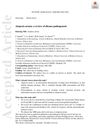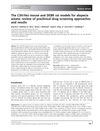A Chronic Contact Eczema Impedes Migration of Antigen-Presenting Cells in Alopecia Areata
May 2006
in “
Journal of Investigative Dermatology
”
TLDR Chronic contact eczema may help hair regrowth in alopecia areata by reducing certain immune cell movement.
The study investigated the effects of chronic contact eczema on antigen-presenting cell (APC) migration in alopecia areata (AA) using a mouse model treated with squaric acid dibutyl ester (SADBE). It was found that while T-cell migration was unaffected, the treatment altered the chemokine environment, increasing monocytes in the skin and reducing dendritic cells in lymph nodes, which impeded APC migration from the skin to lymph nodes. This impaired migration potentially reduced T-cell activation, aiding hair follicle recovery. The study concluded that the therapeutic efficacy of SADBE in AA might be due to altered leukocyte traffic, specifically the reduced migration of APCs, with hair regrowth observed in 50-70% of human patients and 100% of mice.






